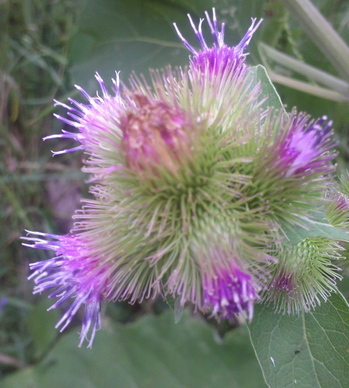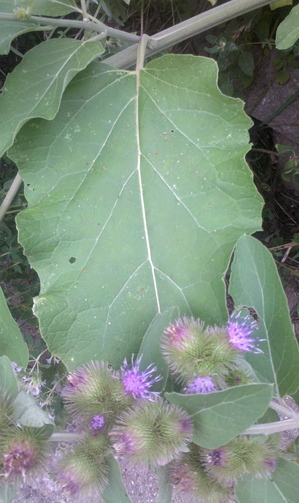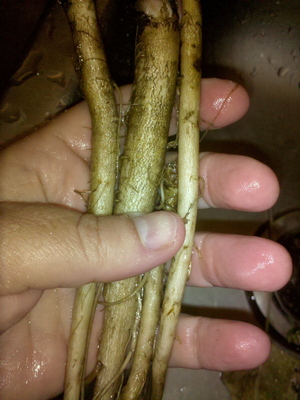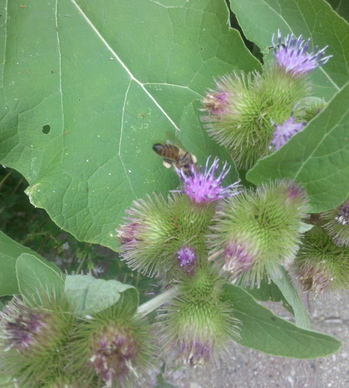Wildcrafting: burdock, bees and burns

The burdock flower. The subsequent burr was the inspiration for Velcro, and the bane of farmers and dog owners.
Linda Diane Feldt | Contributor
Yet this is an incredibly versatile, valuable plant. I welcome it in my yard - up to a point. Most recently I’ve been pulling the first year plants out of my newly built raised beds. The soil is so light in my new garden that I can actually pull it out by the root, a very rare treat, as the roots usually require careful and deep digging for a foot or more.
Once extracted, the roots are tasty raw or can be stir fried, baked or steamed. I’ve eaten them as part of an egg dish, with greens added, with tempeh or tofu, or even baked with other seasonal veggies and potatoes. The taste is crunchy, earthy, a little sweet, and dark.
One of my favorite ways to use a lot of burdock is to add it to a kim chi recipe. The sweet goes well with hot, the texture holds up as the vegetables melt a bit with brining.
But I’ve gotten ahead of myself. What is burdock?

The large burdock leaf is seen here with a flowering stalk crossing it.
Linda Diane Feldt | Contributor
Arctium lappa is a biennial, meaning it lives for two years only. It grows in a low rosette the first year, and in the second year focuses all of its energy on wide-ranging flowering stalks. The leaves range from medium to huge, with a slight resemblance to rhubarb and skunk cabbage and an even more distant similarity to prairie dock. It grows well in hard, clay, compacted soil. I have tended to find it on the sides of fields, against my foundation, and in the paths of my gardens.
The root is a long tap root, smaller in the first year, which is still useful the spring of the second year. But after that it is woody and not good for much at all. The root can be anywhere from a few inches to even two feet in length, and more than an inch in diameter. For eating the first-year roots - as they grow from pencil size to thumb size - are the best.

These are first-year roots, prized for their tender slightly sweet and earthy taste. They can be used raw or cooked.
Linda Diane Feldt | Contributor
The root is used in Japanese cooking, called gobo, as well as prized in biodynamic recipes. Use it like you might a carrot; it has similar versatility as far as being tasty raw or cooked. Grated, chopped or sliced, it is pleasant however you like it.
Some references suggest eating the leaves and peeled stalks as well, but I very much dislike the taste. Yet there are those huge wonderful leaves. What are they good for? It took me years to discover the value of burdock’s leaves for healing large scrapes and rashes. The mashed leaf is applied directly to the cleaned wound, for 20 minutes at a time, and it speeds the healing. So much so that it is very important that the wound be clean. Trapped bacteria can cause infection. Soap and water, a wash with goldenseal (the only purpose for which I suggest using goldenseal), or using another antiseptic wash are advised before using the burdock leaf poultice.
The leaf is also great for relief from the pain of both chemical burns and scalds. I’ve had numerous occasions to test this, from simple burns to touching mucous membranes after handling hot peppers. Whether it is your ears, nose, mouth, or other areas, a bit of ground up or juiced leaf can bring immediate relief. I make it into an oil, salve or tincture, and have found it effective in those forms as well and convenient in the winter. Of course a more serious burn requires medical attention, but the milder injuries respond well to burdock leaf.
The root has many medicinal uses. It is one of the ingredients in Essiac Tea, used to reduce cancerous tumors. There are promising studies on its effectiveness for slow growing tumors. While the recipes vary, it is traditionally combined and prepared with Turkey Rhubarb Root, Slippery Elm Root and Sheep Sorrel in specific ratio. It also can be helpful for skin problems such as psoriasis and eczema, but it takes a long time to work, and even then it works slowly. Usually the tincture is made and used internally for that purpose, but an external salve can also be helpful.
Burdock root contains high levels of inulin, similar to chickory and dandelion. Inulin has been shown to increase calcium absorption for girls, a fabulous side effect. The results were promising enough that Stonyfield Farms yogurt company started adding it to its yogurt as a matter of course.

One of my bees is collecting from the burdock flower. You can see she has a load of pollen to bring back to the hive as well.
Linda Diane Feldt | Contributor
Burdock has many other uses and benefits. When I went outside today to take some photos of the flowers, they were loaded with at least 6 species of bees, including my own honeybees. I’ll take down most of my flowering stalks before they go to seed to control next year’s crop, but not until the bees have had their fill.
George de Mestral is credited with inventing Velcro, based on his observations of burdock’s burrs. For that alone, we should be appreciative of this plant.
Linda Diane Feldt is a local Holistic Health Practitioner, writer, and teacher. She has been teaching herbology and foraging for almost 30 years. Her next free class on herbs will be from 7-8:30 July 22 at Crazy Wisdom Bookstore sponsored by the People’s Food Co-op. The topic is teaching children about wildcrafting and foraging. It will be held in the midst of the art fair, so you can take a break and enjoy the air conditioned space and a change of pace! If you park over by the Co-op you should be able to walk the few blocks to Crazy Wisdom. Follow Linda Diane on twitter, or visit her web site, she can be reached at ldfeldt(at)holisticwisdom.org


Comments
Linda Diane Feldt
Wed, Jul 14, 2010 : 9:30 p.m.
@amsims, The word "dock" refers to large leaves. It could be any number of plants. So you'll need to be more specific than that. However, yellow dock (Rumex Crispus) is used for bruises and sprains, an oil can be made from the root for that purpose. It is used externally in that form. That isn't a well known use, so I'm not sure if that is what you were referring to. You can contact me privately once you have a better identification of the plant in your yard, if I know anything about it I'm happy to pass on information. 734-662-4902 or ldfeldt(at)holisticwisdom.org
amsims
Wed, Jul 14, 2010 : 8:58 p.m.
I have a lot of dock (not burdock) in my yard and had heard something about dock being useful for burns/bruises etc. - would you use it similarly to burdock? Have you done an article about dock yet? (hope this is not off-topic).
betsy shipley
Wed, Jul 14, 2010 : 4:01 p.m.
Since you mentioned tempeh and we lived in Michigan and produced Betsy's Tempeh and did many tempeh demos at the Ann Arbor food coop, I thought you and your readers would like to know about our easy method for making tempeh. www.makethebesttempeh.org Enjoy Betsy Shipley
Linda Diane Feldt
Wed, Jul 14, 2010 : 9:49 a.m.
Actually it wasn't a typo. If you read the story, burdock leaves are very effective in relieving the pain of burns - hot peppers, mild skin burns, etc. I intended it to say "burns" in the headline. I hope it can be changed back... As for the use of roundup, with a biennial plant, it is just as easy to stop the 2nd year flowering stage by cutting it down and save introducing more roundup into the environment. And, my personal opinion, I'd rather not give Monsanto any more profits. Last weekend I simply took my loppers to a large patch of burdock and it was finished off in minutes - no reproduction for next year. No burrs produced this year.
tlb1201
Wed, Jul 14, 2010 : 9:33 a.m.
Uh, shouldn't that header say "burs" instead of "burns"? Not a good thing in a horse's tail, tasty in a stir fry or not. A couple of applications of Roundup when the plants are small usually solves the problem!
Rork Kuick
Wed, Jul 14, 2010 : 8:31 a.m.
Ya, they're pretty good. My major desire is that we all kill this pesky invader. If you have cancer, see a doctor.